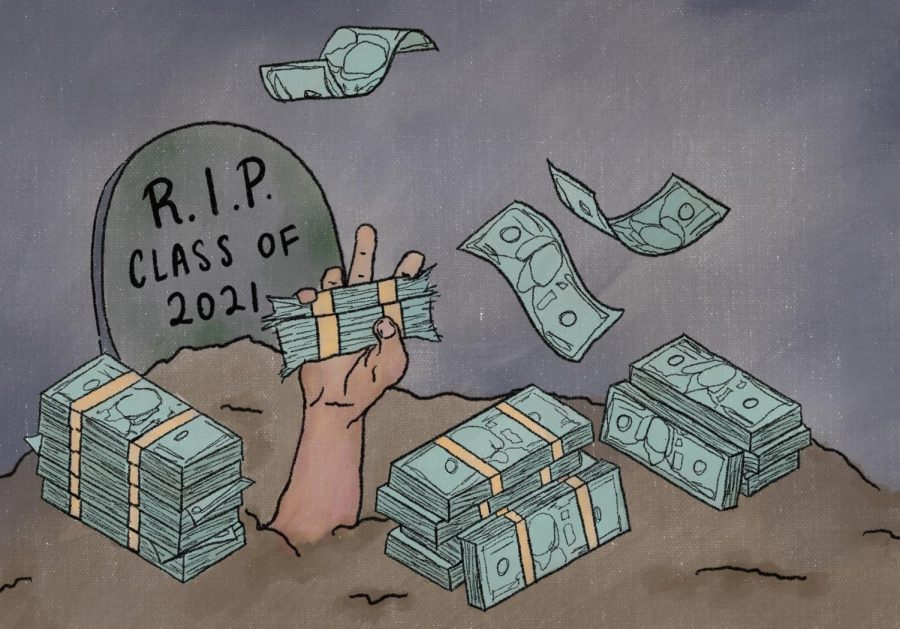Baruch financials show increase in revenue and net position amid pandemic
December 11, 2021
Since the start of the coronavirus pandemic in March 2020, Baruch College’s revenue has increased, mainly due to the decrease in expenses for student organizations.
The Bernard M. Baruch College Association College Inc.’s net position in the 2020-2021 fiscal year increased by $2,82 million which is an 87% increase from the previous year, according to financial statements obtained by The Ticker.
The net position, a way to determine financial health, is defined as the difference between assets and liabilities.
In the 2020-2021 fiscal year, which ended in June 2021, 49% of Baruch’s revenue came from student activity fees — a total of $4,27 million. Revenue coming from student fees increased by 11.6% compared to the previous fiscal year.
At the same time, total operating expenses decreased by 36.2%, totaling $5,82 million saved. In the 2018-2019 fiscal year, before the pandemic, operating expenses were $16,01 million. These numbers indicate a 63.66% decrease in expenses from pre-pandemic levels.
Baruch charges $125.60 for student activity fees per semester for full-time undergraduate students, $85.60 per semester for undergraduate part-time students and $80.45 per every summer session. Graduate student fees are $39.60 for the fall and spring semesters and $14.45 per summer session.
Even though the expenses related to student activity fees have decreased significantly since the pandemic started, student activity fees are still being included in tuition at the same amount.
“Overall all decreases were due to cancellation of student clubs and athletics events from the period of mid-March 2020 to the end of the spring 2021 semester as a result of COVID-19 pandemic,” the 2020-2021 report stated about the significant decrease in expenses.
Similar to the 2020-2021 fiscal year, the report from the previous year stated that the total expenses for that year were $9,13 million.” This marked a decrease of $6,89 million or 43% compared to the previous year.
“The major components of this variance related to decreases in student building fund expense of $6,064,408, athletics and recreation expense of $307,445 and student clubs/organizations/activities expense of $236,753,” the 2019-2020 report said.
According to the financial statements, Baruch’s revenue in 2020-2021 came from the following sources: 49% from student activity fees, 45% from donated space and services, 5% from CUNY support and 1% from other sources.
The percentage of funds allocated to certain expenses were as follows: 38% for athletics and recreation, 19% for management and general, 19% for student life, 6% for student building fund, 6% for student clubs/organizations/activities, 5% for health and wellness, 4% for student government and, finally, 3% for publications and promotions. Baruch issues a statement in response to The Ticker’s questions regarding the possibility of a decrease in student fees.
“The Undergraduate Student Government is the conduit for the allocation of funds for student clubs. As part of the process, student clubs submit budget requests to the USG, which, in turn, present to the Association’s Budget Committee for approvals,” said the statement, which was sent to The Ticker via email.
“As in previous years, any unused student club monies are expected to fund future budget requests from student clubs. Additionally, unused earmarked funds will be there to use during this upcoming spring semester, which, as of now, is projected to bring more on-campus and virtual events and activities for students.”
The amount and schedule of Baruch’s student activity fees are determined by a student referendum, which is then approved by the CUNY Board of Trustees. The current student activity fees schedule was set in 2011, according to the statement.
“Since the student activity fees are earmarked according to that 2011 approved referendum, neither the Association’s Board of Directors nor the College has the authority to reallocate these earmarked funds.”
In addition to their concern about fees, many students say tuition should be cut.
Since the beginning of the COVID-19 pandemic, Baruch students have been vocally demanding the school to reduce tuition due to the switch to remote learning. Students have expressed their demands by signing various petitions to push for the cause.
In July, former Gov. Andrew Cuomo announced the CUNY Comeback Program, which would eliminate $125 million of unpaid debt for students who were enrolled in classes from March 2020 through the spring 2021 semester.
“CUNY students showed their great resilience in the face of the immeasurable hardships they faced over the past 16 months, from employment and income loss to food and housing insecurity, amid an unprecedented health crisis that brought sickness and tragedy to thousands of New York families,” CUNY Chancellor Félix Matos Rodríguez said.
The program’s goal is to remove financial barriers to the education necessary for social mobility, according to a CUNY press release.
“This compassionate action will allow CUNY students and recent graduates to move ahead in pursuit of their educational and career objectives without the specter of unpaid tuition and fees,” Matos Rodríguez said. “This landmark measure will also enhance CUNY’s important contributions to New York’s economic recovery.”
Even though the CUNY Comeback Program is expected to help more than 50,000 students with outstanding debt, it is unclear if there will be a similar assistance program for students who are still facing financial hardships due to the ongoing COVID-19 pandemic during fall 2021 and spring 2022 semesters.
CUNY students also received an email on Nov. 30 from University Dean for Institutional and Policy Research Colin Chellman to complete a student employment and financial needs survey.
“In order to best support our students, we want to understand your current employment status, ongoing needs and necessary supports,” the email read. “This information will be used to raise funds and provide students with the targeted forms of aid and opportunities most needed.”









